
As the holidays are rapidly approaching, I find myself unwrapping a new package from the postman somewhat regularly it seems. While itís taken a bit of work up front, the pieces and parts for this build are finally starting to trickle in. A goodie box from Renthal, a new front hood from Fourwerx Carbon and much more. While it might be easier to just spend one day outfitting it with all the products from the different companies that are helping out, weíve decided to build this quad in stages so we can really highlight the products themselves and the function that they offer.
Being that this stage of the build focuses on traction, how better to illustrate that than with a brand new set of tires from Goldspeed Racing Products. Having worked in the industry for a while and spent countless hours at the track, everyone seems to share the same amusement for new tires. Some of the top racers are fortunate to have a new set for each race and some even each moto! The rest of us arenít quite that lucky, which I guess is why getting a new set of tires, regardless of the brand, always makes you feel good inside.
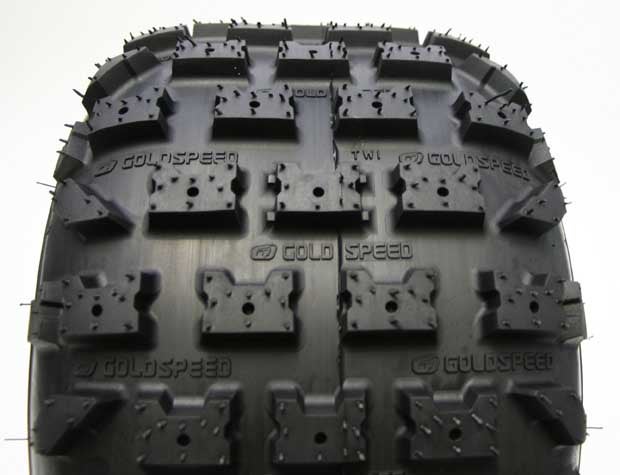
Goldspeed Racing Products is a European-based company that places a major emphasis on engineering and design. While their tires arenít necessarily the cheapest in the industry, their performance is second to none, and a number of todayís top racers have raced and won on them.
Now if youíre from the racing industry, you may have realized that it was pretty hard to find a set the last couple of years. The reason for that is Goldspeed changed distributors and ended up without a solid distributor for the 2012 season. Early in 2013 however, GPS Offroad Products came on as the new US distributor and is again making these tires available to ATV racers here in the States.

I had a tough time deciding whether to go with a 20Ē XC setup or the smaller 18Ē MX tire. I really enjoy riding both the track and the trails, but most MX tires feature a standard four-ply rating. While most tracks donít have a lot of rocks and tree roots, Iíve learned my lesson riding on trails with only a four-ply tire.
As it just so happens, Goldspeed offers a six-ply motocross tire called the MXR-2. This tire features a six-ply rating while remaining only 18 inches tall to keep that lower center of gravity for MX racers. The tread pattern is an aggressive, direction lug featuring a scoop pattern on the front with a solid blade in the back. While the scoop is designed to provide optimal traction in most conditions, the user has the option of turning the tire around as an extra option or simply to get a little more life out of the tire.

One thing that Goldspeed is known for is the different compounds of tires that they offer. Part of that premium price is a silicone additive that they add to the rubber compound to make it extra tacky. Most of its MX tires come in three different compounds red (soft), blue (medium) and yellow (hard).
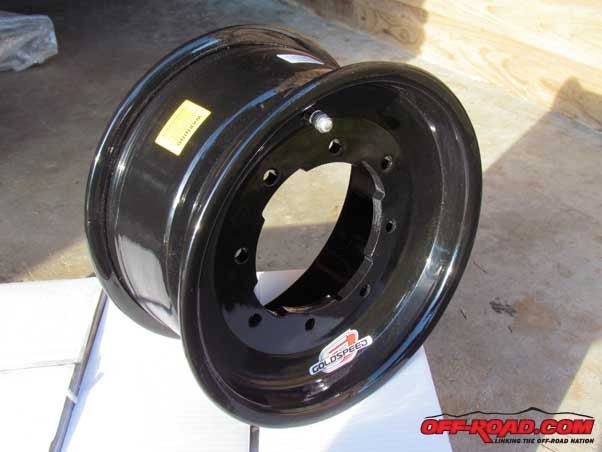
Although the softer the tire is the faster it will also wear out quicker, but for many racers looking for maximum hook-up thatís a sacrifice theyíre willing to make. The set I went with is the blue compound to provide the best traction in the widest variety of conditions. The six-ply ratting also ensures me excellent puncture resistance in the event I decide to hit the trails.
Up front I went with the companyís 21-inch yellow Compound SX footprint. If the tread pattern looks familiar well thatís because just about every ATV tire manufacturer in the world offers some variation of it. Some are direct copies and some have slight modifications, but the biggest reason as to why this particular footprint is so popular is simple Ė it works! The 13mm tall, square knobs are evenly spaced and placed at different angles to offer maximum straight-line as well as turning traction. Because itís an XC tire, this tire has a six-ply rating along with Goldspeedís puncture proof material (PPM) in the sidewall.
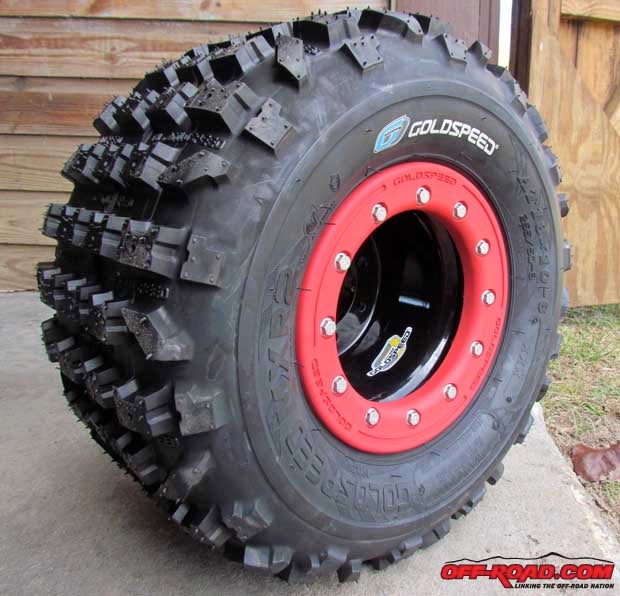
The standard MX setup calls for an 18-inch rear tire and a 20-inch tire up front, but the 20-inch tires always seemed so small to me. I like the look of the taller tire, and in the event that I decided to switch it up and install an XC rear tire I wonít have to replace the front tires.
In addition to the new rubber, Goldspeed also supplied us with a set of their brand new aluminum beadlock wheels. This wheel is similar to other beadlocks on the market with a few very useful upgrades. The wheel itself is .190-thick spun aluminum and is heat-treated for added strength. It features a rolled inner lip for increased durability as well as a beadlocking outer ring to ensure the tire doesnít slip on the rim when itís biting the ground. The wheels we used are a standard 8x8 size with a 3x5 offset.
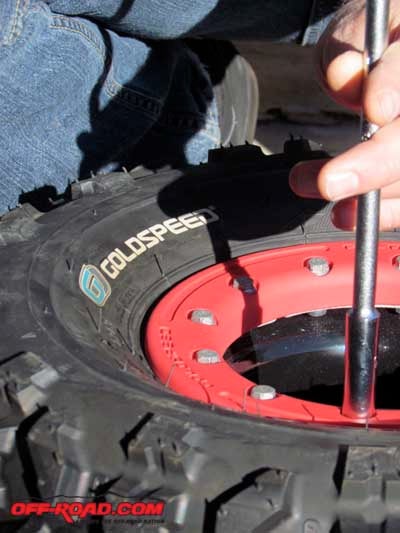
One significant feature that we really like about these wheels are the upgraded nut plates. Over the years, the means by which the ring is actually bolted to the wheel have changed significantly from individual nuts and bolts to small dual nut plates and now to riveted in nut plates. Goldspeedís nut plates are by far the beefiest weíve seen, which means thereís less of a chance for cross threading the bolts when mounting the beadlock ring. Speaking of rings, Goldspeed offers two different types of rings with their wheel, a standard machined aluminum ring and a trick, carbon-fiber ring. Although the ring isnít 100% carbon fiber, itís a tad lighter than the standard aluminum one and it doesnít show wear nearly as much. Traditional aluminum rings are powder-coated different colors but as soon as you nick a rock or a tree, the powder coat wears off and the raw metal shines through. Because the carbon rings are molded, all the material used in the ring is the same color, so even if you were to put a big gash in the ring you would still see the same color and the mark would be less noticeable. We opted to go with red rings since weíll be working several other red products into the rest of the build.
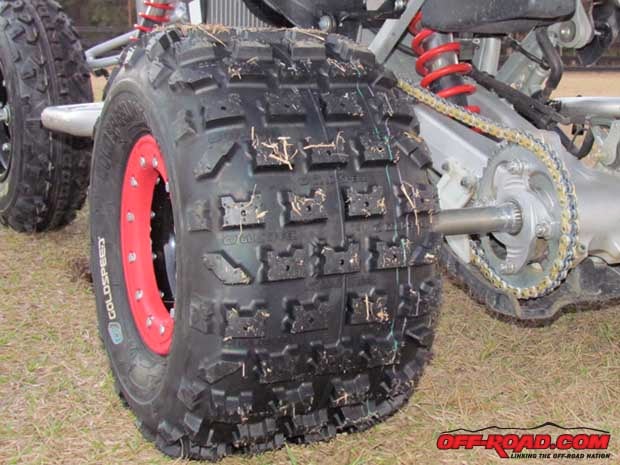
Up front weíre using a rolled lip, non-beadlock wheel featuring the same .190 thick material and heat treating as the rear. There are different schools of thought as to whether a beadlock on the front is really necessary. A lot of XC racers swear by them; however, a number of West Coast WORCS racers and desert racers consider them to be just excess weight. Because the front tires are driven tires as opposed to drive tires, there is much less force on them and thus less of a chance the tire will slip on the rim. For MX applications there really is no need for them.
As a final bonus, both the front and rear wheels feature a universal bolt pattern. The front 4/144 and 4/157 as well as the rear 4/110 and 4/115 will fit almost every modern sport ATV model. Thatís good news if you plan to switch machines anytime in the near future, as you wonít have to worry about your wheels not matching up.

We reached out to Renthal after realizing that the chain and sprockets were still the original stock units from 2005, so turning those brand new tires and wheels is a chain and sprocket combo from Renthal. The R4 ATV Z ring chain is their flagship chain for ATVs. A 520 chain is the standard for aftermarket applications and the R4 ATV Z Ring features gold-anodized side plates to reduce rust and corrosion. We think it adds a little extra bling as well. The patented Z rings are designed to absorb more of the specially formulated grease that is used when the chain is assembled, prolonging the life of the chain by ensuring better lubrication. Larger diameter pins manufactured from specially enhanced steel improve the resistance to shock loads, and a quad-riveting process on each pin increases the tensile strength of the chain to over 8000 pound force (lbf). As a nice touch, Renthal includes a set of rubber gloves with the chain to keep your hands from getting greasy. Well played Renthal, well played.
The 14-tooth stock countershaft sprocket was showing some major wear, so we replaced it with Renthalís Ultralight grooved front sprocket. Iíve broken teeth off sprockets before, and if you mange to throw the chain in the process it can cause major (and costly) damage to the crankcase. Not to mention itís a real pain in the butt trying to unwind it out on the trail or in the dunes so you can tow it back to camp.
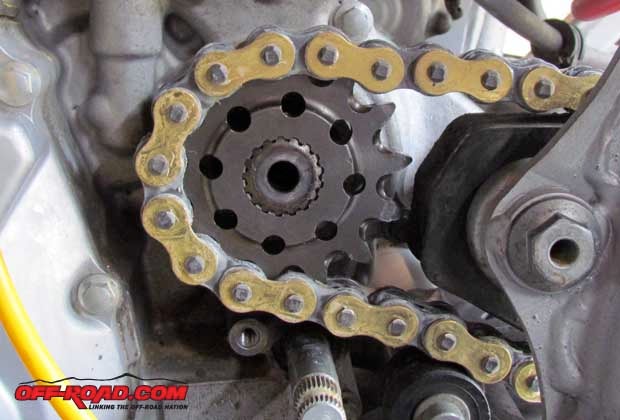
The Ultralight countershaft sprocket is machined from 655M13 nickel chromium steel and is case hardened for durability. Case hardening, also known as surface hardening, is a process of reinforcing the outer layer of steel to increase durability.
To help prolong the life of the chain as well as the sprocket, mud grooves are machined into both sides of the teeth to allow mud to flow away from the major contact points. Chain maintenance is commonly overlooked so every little thing that helps maintain the lifespan of the drive system is a plus.
Renthal also supplied us with an Ultralight aluminum rear sprocket to replace our stock steel one. Nothing robs horsepower like revolving mass so cutting the weight down on everything that spins is important. Evidently the Ultralight rear sprocket is a tad wider than the stock sprocket because the heads of the mounting bolts were making contact with my twin row bearing carrier. Because of the tight tolerances, I decided Iíd stick with the stock sprocket and fortunately it wasnít worn nearly as bad as the countershaft one was. Iíll likely get another replacement in the near future.
Items like a chain and sprockets donít necessarily do a lot for the appearance of the quad but they can make a world of difference in terms of performance, and are good insurance against breaking a chain or sprocket. The tires and wheels really give the quad a nice look and the red carbon rings will accent the rest of the red on the quad as the build continues to come together.
Stay tuned for the next phase as we continuing bringing this revive project back to life.
MORE ON THIS PROJECTHonda TRX450R Revive Project, Part 1


 Your Privacy Choices
Your Privacy Choices